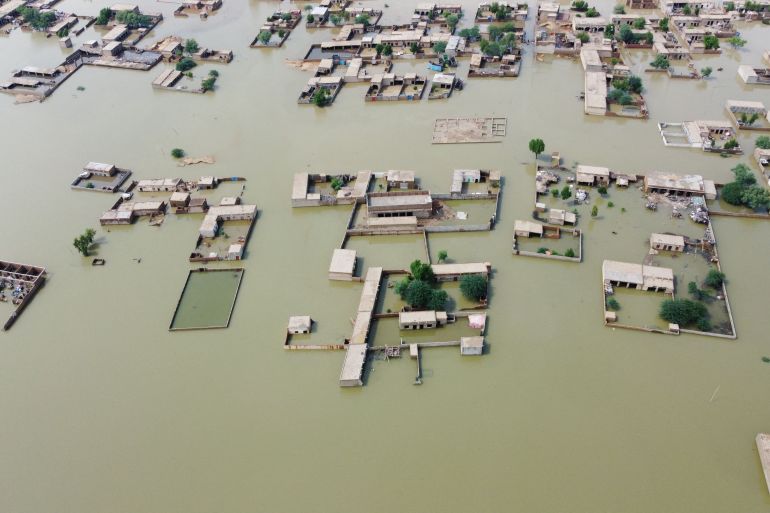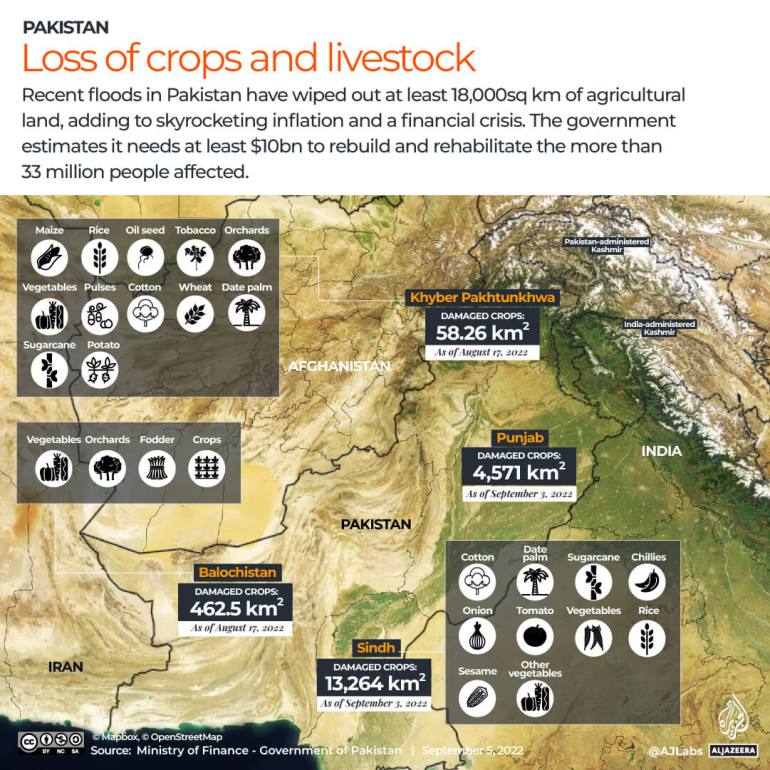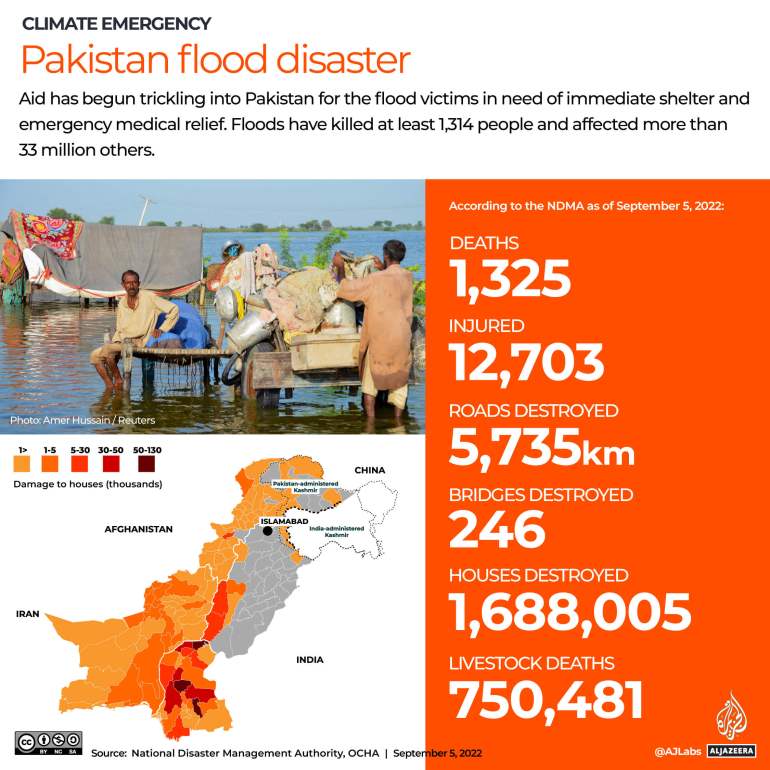After record floods, now Pakistan has to worry about economy
The rain has destroyed vast hectares of crops, including cotton, a key source of employment and forex for the nation.

Islamabad, Pakistan – Tanveer Aziz Kingrani was planning to spend August preparing for his term examinations at the University of Sindh. Instead, the 23-year-old aspiring physicist has been camping out in a tent with 18 family members for the past week after his village was completely submerged in floods.
A resident of Haji Manik Khan village, 20km (12 miles) from Dadu city in Pakistan’s southern province of Sindh, Kingrani and his family are among the 33 million people who have been forced to leave their houses due to the unprecedented rains and floods that hit the region last month.
Keep reading
list of 4 itemsPakistan hit by floods and political crisis
Pakistan appeals for more aid as flood death toll rises
Photos: Flood-hit Pakistan now fights waterborne diseases
But it was not just the homelessness that was on Kingrani’s mind.
“Our crops are completely destroyed. We have nothing left for ourselves, or for the market. We have suffered a loss of at least 1.8 million Pakistani rupees [$8,000],” he tells Al Jazeera over the phone.
On the 12 hectares (30 acres) of farmland that Kingrani’s father owns, he sows rice, cotton, and wheat during the winter. But the rains have not only destroyed his standing crops of rice and cotton, the Kingranis are now worried about their wheat crop as well.
“There’s so much water that there is no chance of it receding or draining before the next three months, and that means we will miss out on the timeframe to sow the wheat crop,” says Aziz Kingrani, Tanveer’s father.
“I have no other source of income besides my land and my pension,” says Aziz, a retired professor. “I have no idea how I will feed 18 people with my meagre pension. I may just have to recall my son from his college to help me out.”
Some 800km (500 miles) northwest of Kingrani’s village, similar tales are unfolding in Balochistan, Pakistan’s most impoverished province that saw 500 percent more precipitation than the annual average in the month of August.
Abdul Bashir Jatoi, a farmer in Dera Allah Yar city, says his entire village, including 10 hectares (25 acres) of farmland, has been submerged. As have the roughly 800 hectares (2,000 acres) of arable land in the adjoining four to five villages.
“I had invested close to 500,000 [Pakistani] rupees [$2,240] for my rice crop, hoping to earn a profit of close to 1,500,000 [Pakistani] rupees [$6,720] but it was not to be. Now I am just waiting for God to send some help,” the 45-year-old farmer told Al Jazeera.
This has been the story of just about every household affected by what is inarguably Pakistan’s worst ever floods, as torrential monsoon rains have caused havoc in the South Asian nation of more than 220 million people.
More than 1,300 people have so far died, with 81 out of 160 districts in the country directly affected by the floods, leaving at least 33 million people homeless, figures which are expected to rise in the coming days.
But beyond the human losses, the country’s economic managers have the most challenging task ahead as floods ravaged the country’s road and communication network, damaged an incalculable number of houses, and destroyed millions of hectares of crops.
Low forex, high inflation, devastated crops
The agriculture sector makes up nearly a fourth of Pakistan’s gross domestic product at 22.7 percent. Its massive destruction – including that of the cotton crop, a key source of revenue for the country – comes at a time when Pakistan has been struggling with fast-shrinking foreign exchange reserves and when it is already reeling under severe inflation, which touched 27.3 percent in August, a five-decade high
As per a UN Food and Agriculture Organization August 29 report, almost 80 percent of crops in Sindh, which produces roughly 30 percent of Pakistan’s total cotton output, were destroyed.
Close to 70 percent of Pakistan’s textile industry, an important source of employment and foreign exchange, uses the cotton produced in the country. Since nearly 35 percent of that is produced in Sindh province by farmers like Kingrani, the sector is girding itself for a shortage, said Abdul Rahim Nasir, chairman of All Pakistan Textile Mills Association, an industry body.
This, Nasir said, could set the country back significantly, especially with its dwindling foreign currency. “We often import over four million bales to meet our requirements. Due to the current shortage, we may end up having to import double that, at a potential cost of close to $3bn,” he said.
While Finance Minister Miftah Ismail estimates that the country has incurred a total loss of “at least $10bn”, independent analysts, including Uzair Younus, director of the Pakistan Initiative at the Atlantic Council’s South Asia Center and economist Ammar Habib Khan, put the figure between $15bn and $20bn, and expect it to rise further as information is coming in with a lag.
Their calculations are based upon data compiled by the National Disaster Management Authority as well as its provincial off-shoots, the Provincial Disaster Management Authority, Younus said.
However, experts have warned that while the direct financial cost of the disaster in terms of lost bridges, buildings, road networks, crops and livestock can be determined, what the government will have to also prepare for is its spillover effect on the rest of the economy.
“What will be harder to determine right now is the broader economic loss, such as through decrease in economic activity, knock-on effects on cost of living. It will take months to determine these comprehensive losses,” said Shahrukh Wani, an economist at the Blavatnik School of Government, University of Oxford.
IMF conditions
For now, the more immediate challenge that Pakistan’s economic team will face is to fulfil the conditions of raising taxes and applying austerity measures as part of its agreement with the International Monetary Fund for its bailout package, which was approved last month for the cash-strapped country.
Wani, the Oxford economist, says the flood will make it terribly difficult for the government to reduce its trade deficit targets because while the country will need to import food to “compensate” for lost crops, the textile sector will find itself struggling due to a potential shortage of cotton crop.
“This fiscal space will become tighter from both ends. From the revenue side, the government will lose revenue from the loss of economic activity. On the spending side, the government has had to extend significant humanitarian support and reconstruction activities,” Wani said.
While agreeing with the precarious state of affairs, Khalid Abdullah, cotton commissioner of Pakistan’s Ministry of National Food Security, said that the government is still “assessing exact figures of loss” and focusing more on “relief work”.
There may be a slight respite in sight as flood damage was limited in Punjab province, one of the key agricultural areas, pointed out Muhammed Ali Talpur, another senior official at the Ministry of Food Security and vice president of the Pakistan Central Cotton Committee.
“Flood damage in Punjab was limited to only Rajanpur and Dera Ghazi Khan. Hopefully, they can give good results,” Talpur said.
But for the business community, the situation looks unsalvageable this year.
Kamran Arshad, managing director of Lahore-based Ghazi Fabrics International says it is impossible to hope that the cotton crop in Punjab could offset the losses incurred in Sindh.
“More than 80 percent of Sindh’s crops are damaged. We have considerable damage in Punjab as well. Quality of surviving crops is not up to the standard either so we don’t know how much of it can be used,” he told Al Jazeera.
“I think a lot of cotton will be imported this year,” he said.

